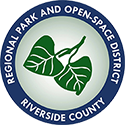Habitat Studies
The program includes the releasing of trout in the nearby Diamond Valley Lake Reservoir. View the most recent TIC activities and trout release at E. Hale Curran school.
4th & 5th Grade Seed Bank Studies
In the third grade component, the students became acquainted with the threatened and endangered plants and animals that are found at the Reserve and in other similar open spaces. They were introduced to habitats and some natural science terminology.
The next step in the pathway for 4th and 5th graders is to begin to understand ecosystems at the Reserve, especially the grassland areas and the native plants that comprise grasslands.
They learn how open space and grasslands disappear and how native plants, mammals, birds and insects create an intricate web of life. The lesson starts with learning how to identify native from non-native plants. They discuss how the non-native plants can take over the native plants. They harvest native seeds from the Reserve and grow them in their classrooms and keep a journal of the process of harvesting, planting, monitoring and transplanting.
Students also learn that removing native species (plant and/or animal) from an ecosystem is like taking rivets out of an airplane wing; it is impossible to know which one will be the last one that was holding the whole thing together.
Middle School Grassland and Watershed Restoration
Middle School Grassland Restoration
The grassland restoration program takes place over an eight-month period beginning in October and concluding in June. The same classes of students return approximately every three weeks for half-day field work instructed and mentored by teachers, Naturalists and Botany graduate students from the University of California Riverside.
Students gain awareness of how environments and habitats become altered and endangered and how that affects our world. They are allowed to go off trail in search of a grassland plot on the Reserve in need of restoration. The learn how to articulate elements of the section such as its soil and plant condition; and the number and type of native and non-native plants. They research the different techniques for restoring a grassland and set about to develop a plan and conduct the actual work associated with the restoration. In the process the learn field biology/ecology techniques and science techniques.
Those students who participated in the 5th Grade Seed Bank Study, and now entering the feeder middle school, will be mentored to share their experience of identifying, growing and analyzing native plants.
Elementary & Middle School Watershed – Trout in the Classroom
Students become acquainted with local watersheds including Cole Creek located on the Reserve. They begin to lean about the water quality of these local watersheds and how that quality affects the survival of animal life in the water habitat and along the creek beds.
This program includes a Trout in the Classroom (TIC) component that is interactive and takes place in the classroom and at a local reservoir. TIC is an environmental education program in which students:
-
raise trout from eggs to fry,
-
monitor tank water quality,
-
engage in stream habitat study,
-
learn to appreciate water resources,
-
begin to foster a conservation ethic and
-
grow to understand ecosystems.
High School Habitat and Watershed Studies
The high school Habitat Studies and Restoration program continues every two weeks for eight months beginning in October to May. Students are now engaged in advanced field work in two habitats/ecosystems – Grassland and Watershed. The watershed study focuses on why the Steelhead trout is a threatened species in our local watersheds.
They will analyze the habitat condition of each and propose science questions as to how the areas or species can be restored. Science and Chemistry teachers and graduate students are involved in guiding students as they develop a scientific-based restoration plan in answer to the question posed. They will perform soils and water analysis; research the natural history of the habitat and develop a proposed restoration plan; they document and report their findings and results at the end of the eight months. High school students will learn how to mentor the middle school and elementary students participating in the seed bank and middle school grassland programs.
Send us an email, give us a call, or come see us.
Email: info@the-nef.org
Phone: 951-319-2998
Office: Monday – Friday: 9:00 am – 5:30 pm
Visitor Center: Santa Rosa Plateau Ecological Reserve
39400 Clinton Keith Road, Murrieta 92562
TNEF is partnered with RivCoParks to provide nature education programs at the Santa Rosa Plateau Ecological Reserve. Visit their website for information about their programs and properties in Riverside County.
Sponsor Highlight
Each month we’ll introduce you to a sponsor who has embraced the value of “corporate social responsibility” with their support of our mission via event and program sponsorships. Please consider this local company for your family and business needs.
Winchester & Associates Insurance Services
A boutique agency specializing in Hard to Insure homeowners, commercial business, Medicare and agribusiness insurance. We are here to help protect what you love. To get a quote click here.




